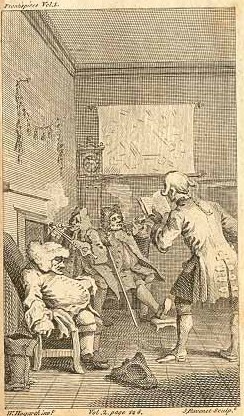Hidden Revolutionaries: Tristram Shandy and Adam Smith
September 1, 2022

Modern readers can easily forget how revolutionary ideas from the past were. Laurence Sterne’s Tristram Shandy (and James E. Hartley) are here to remind you.

Modern readers can easily forget how revolutionary ideas from the past were. Laurence Sterne’s Tristram Shandy (and James E. Hartley) are here to remind you.
Adam Smith’s The Wealth of Nations suffers from a familiarity bias in the modern world. It is difficult to get people excited about a book that explains how the division of labor leads to specialization and trade which then creates immense wealth. The shocking nature of the work is hidden from us because we all see this every day and thus think of it as nothing particularly revolutionary.
A good comparison is provided by Isaac Newton’s Principia. In that book Newton demonstrated that the same force that causes apples to fall from trees to the ground can explain planetary movements around the sun. The shocking nature of this is hard to underestimate. As Alexander Pope described it: “Nature, and Nature's laws lay hid in night./ God said, Let Newton be! and all was light.” Newton had turned the entire solar system into a giant machine, following regular laws of behavior. Yet, because everything in it seems so obvious now, few people today are rushing out to read Newton’s work.
In exactly the same way, Smith turned the idea of economic society into a giant machine. It may seem like uncoordinated specialization would lead to total chaos, but there is something akin to an invisible force which induces all the parts to work together into a harmonious whole. Society is not nearly as fractured and disorganized as it first appears.
The reason it is hard for us to see the revolutionary nature of Smith’s insight is that we do not always appreciate how the world looked to people before Adam Smith wrote. In other words, we can all profit from spending some time with Laurence Sterne’s The Life and Opinions of Tristram Shandy, Gentleman, published in nine volumes between 1760 and 1767.
On the surface, the novel is Tristram relating the story of his life. But, it takes very little time for the reader to realize this is not a typical autobiographical tale. Tristram begins not with his birth, but rather with the odd circumstances of his conception. It then takes four volumes for Tristram to get to the day he was born. Why the delay? Tristram’s narrative style is that of an easily distracted squirrel. Digressions pile upon digressions. As a reading experience, the only choice is to settle in and go along for the ride. It is a rather amusing book.
If you step back from the details of the book, it is immediately obvious that the novel destroys the idea of linearity. Tristram describes his method of composing the tale: “That of all the several ways of beginning a book which are now in practice throughout the known world, I am confident my own way of doing it is the best—I’m sure it is the most religious—for I begin with writing the first sentence—and trusting to Almighty God for the second.”
The unplanned nature of Tristram’s compositional method perfectly captures the age in which both Sterne and Smith were writing. Just a couple of generations before, you could make a reasonably good guess about the life story of a child at the moment of birth. The son of a farmer would grow up to farm; the daughter of a noble would be married off to another member of the nobility. But suddenly in the 18th century, society was thrown into upheaval as the technological revolution started disturbing economic arrangements. New industries arose and others died off. People started moving from the country to the cities.
Tristram Shandy perfectly epitomizes the chaos of the age. There no longer seems to be a linear or coherent narrative to one’s life. Once you imagine believing this to be true, believing that society has lost all moorings and is becoming nothing but chaos, the genius of The Wealth of Nations shines through. Yes, things look chaotic, but in the midst of all this newfound liberty, there can still be an orderly society.
Indeed, Tristram provides what would have been a wonderful epitaph for Smith’s book. “All I wish is, that it may be a lesson to the world, ‘to let people tell their stories their own way.’” In Tristram’s case, his own way of telling a story created a Great Book. In Adam Smith’s world, telling your story in your own way unbinds your life, freeing you to find a place in an unplanned but still coherent world.
Want to read more?
James E Hartley's "Can Sober Smithians Soften Polarized Partisans?"
Amy Willis' #ReadWithMe: Ritchie Robertson’s The Enlightenment: Science Goes Public
Craig Smith's A Hotbed of Genius: An Introduction to the Scottish Enlightenment
Want to read more?
James E Hartley's "Can Sober Smithians Soften Polarized Partisans?"
Amy Willis' #ReadWithMe: Ritchie Robertson’s The Enlightenment: Science Goes Public
Craig Smith's A Hotbed of Genius: An Introduction to the Scottish Enlightenment